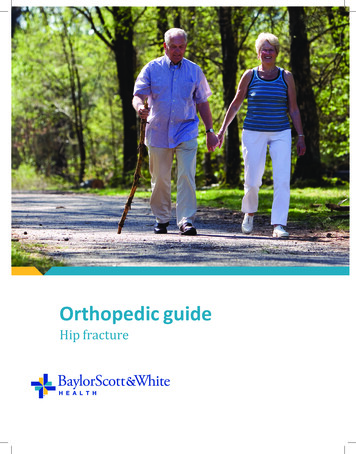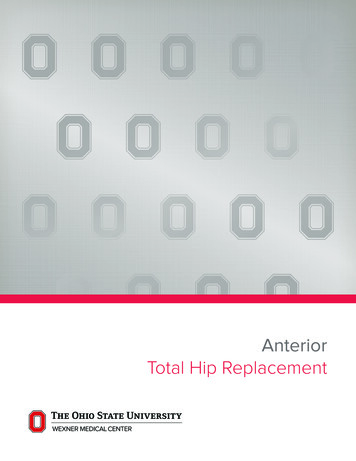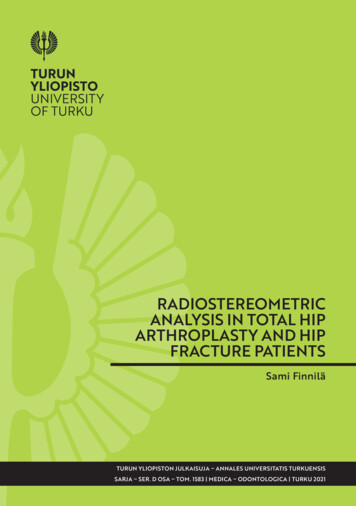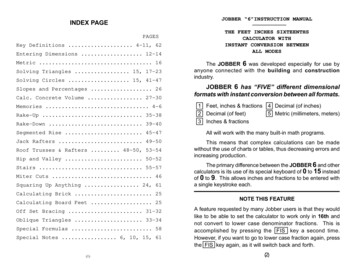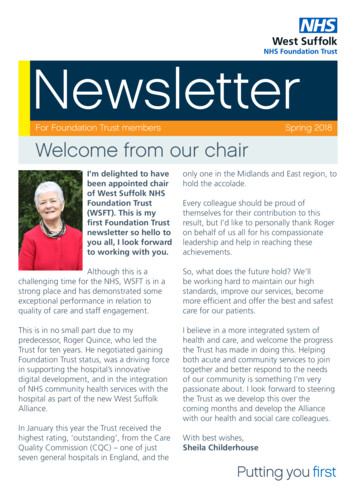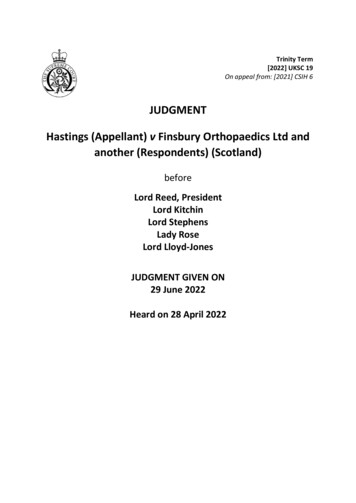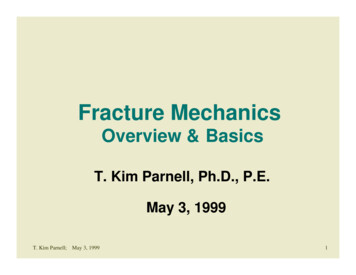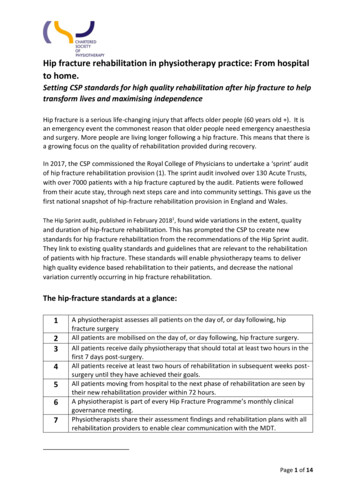
Transcription
Hip fracture rehabilitation in physiotherapy practice: From hospitalto home.Setting CSP standards for high quality rehabilitation after hip fracture to helptransform lives and maximising independenceHip fracture is a serious life-changing injury that affects older people (60 years old ). It isan emergency event the commonest reason that older people need emergency anaesthesiaand surgery. More people are living longer following a hip fracture. This means that there isa growing focus on the quality of rehabilitation provided during recovery.In 2017, the CSP commissioned the Royal College of Physicians to undertake a ‘sprint’ auditof hip fracture rehabilitation provision (1). The sprint audit involved over 130 Acute Trusts,with over 7000 patients with a hip fracture captured by the audit. Patients were followedfrom their acute stay, through next steps care and into community settings. This gave us thefirst national snapshot of hip-fracture rehabilitation provision in England and Wales.The Hip Sprint audit, published in February 20181, found wide variations in the extent, qualityand duration of hip-fracture rehabilitation. This has prompted the CSP to create newstandards for hip fracture rehabilitation from the recommendations of the Hip Sprint audit.They link to existing quality standards and guidelines that are relevant to the rehabilitationof patients with hip fracture. These standards will enable physiotherapy teams to deliverhigh quality evidence based rehabilitation to their patients, and decrease the nationalvariation currently occurring in hip fracture rehabilitation.The hip-fracture standards at a glance:1234567A physiotherapist assesses all patients on the day of, or day following, hipfracture surgeryAll patients are mobilised on the day of, or day following, hip fracture surgery.All patients receive daily physiotherapy that should total at least two hours in thefirst 7 days post-surgery.All patients receive at least two hours of rehabilitation in subsequent weeks postsurgery until they have achieved their goals.All patients moving from hospital to the next phase of rehabilitation are seen bytheir new rehabilitation provider within 72 hours.A physiotherapist is part of every Hip Fracture Programme’s monthly clinicalgovernance meeting.Physiotherapists share their assessment findings and rehabilitation plans with allrehabilitation providers to enable clear communication with the MDT.Page 1 of 14
The key findings from HipSprint audit summarised:Access data about your local phfsa.htmlFind out about hip fracture rehabilitation in your local area by accessing the HipSprint heatmap of services. Search the map for trusts, hospitals, community centres and otherphysiotherapy services. Compare the data from your own service with other services andthe new HipSprint standards to help you identify where local quality improvement worksneeds to be focussed.Further information:enquiries@csp.org.ukPage 2 of 14
Standard 1:A physiotherapist assesses all patients on the day of, or day following, hipfracture surgery.Indicators:a. A registered physiotherapist must perform the assessment.b. The assessment may occur either before or after the operation.c. The NHFD data processor is able to identify the specific assessment of thephysiotherapist for the purposes of NHFD data entry.d. A clear and consistent method for recording the initial physiotherapist assessment isin place.e. The physiotherapist assessment is shared with the MDT to facilitate clearcommunication and efficient care-planning.f. A physiotherapist may undertake a delirium assessment using the 4AT screeningtool.g. A physiotherapist may undertake the multifactorial fracture prevention assessment(falls and bone health).Evidence:National Tariff Payment System 2018-19 for Hip 2017-18 and 201819 National Tariff Payment System.pdfNational Institute for Health and Clinical Excellence. Hip Fracture: Management CG124.London: National Institute for Health and Clinical Excellence l Institute for Health and Clinical Excellence. Delirium: Prevention, diagnosis andmanagement CG103. London: National Institute for Health and Clinical Excellence l Institute for Health and Clinical Excellence. Falls in older people: Assessing risk andprevention CG161. London: National Institute for Health and Clinical Excellence 2013.https://www.nice.org.uk/guidance/cg161Note:In England and Wales, to receive full Best Practice Tariff payment under National HipFracture Database (NHFD) hospitals must ensure a registered physiotherapist undertakes adirect assessment of the patient. Subsequent care and rehabilitation may be delegated toPage 3 of 14
members of the physiotherapy team where appropriate. Patients experiencing dementia,delirium, poor pain control or other complicating factors, either pre- or post-operativelymay require continued assessment and review from a registered physiotherapist as a part ofa multidisciplinary approach to care.Standard 2:All patients are mobilised on the day of, or the day following, hip fracturesurgery.Indicators:a. Any healthcare worker may perform the task of getting a patient out of bed.b. The type of worker(s) involved in getting the patient out of bed is accuratelyidentified.c. A clear and consistent method for recording getting out of bed is in place.d. The NHFD data processor is able to identify when a patient gets out of bed for thepurposes of NHFD data entry.e. A physiotherapist leads modifying physiotherapy treatment plans to enable patientsexperiencing dementia, delirium, pain and hypotension to get out of bed on the dayof, or the day following, hip fracture surgery, where possible.f. A physiotherapist reviews any patient who does not mobilise within 24 hours.For patients who do not get out of bed on the day of, or the day following, hip fracturesurgery:g. A clear record is made of the reason why a patient does not mobilise within 24hours.h. A physiotherapist is involved in the Multidisciplinary Team (MDT) discussion toaddress the reasons for extended bed-rest.i. A clear physiotherapy action plan with timescales is in place to manage the clinicalconditions that prevent a patient getting out of bed on the day of, or the dayfollowing, hip fracture surgery.j. There is a specific range of motion exercise programme in place for patientsexperiencing deliriumEvidence:National Institute for Health and Clinical Excellence. Hip Fracture: Management CG124.London: National Institute for Health and Clinical Excellence l Institute for Health and Clinical Excellence. Delirium: Prevention, diagnosis andmanagement CG103. London: National Institute for Health and Clinical Excellence 2010.Page 4 of 14
https://www.nice.org.uk/guidance/cg103Standard 3:All patients receive daily physiotherapy which should equal at least twohours overall in the first 7 days post-surgeryIndicators:a. The patient’s previous activity levels over the last six months is identified to ensurethat rehabilitation goals are appropriate.b. Any member of the physiotherapy team may provide the identified rehabilitationinterventions.c. A clear and consistent template for recording rehabilitation goals and activities is inplace and shared with the wider MDT.d. Each rehabilitation session includes domains of range of movement exercise,strength and balance training, transfers and walking, and functional ability, asappropriate to stage of recovery.e. Each rehabilitation session is suited to the patient’s identified abilities at the timetreatment is given.f. There is a specific strength and balance training programme in place for patients atlow-moderate risk of falls.g. There is a specific multifactorial programme in place, including strength and balancetraining, for patients at high risk of falls.h. An appropriate outcome measure is used to measure progress against eachrehabilitation goal.Patient who do not receive two hours of rehabilitationi. A clear record is made of the reason why a patient has not received 2 hours ofrehabilitation.j. A clear physiotherapy action plan with timescales is in place to manage the clinicalconditions that prevent a patient receiving 2 hours of rehab.Evidence:National Institute for Health and Clinical Excellence. Hip Fracture: Management CG124.London: National Institute for Health and Clinical Excellence l Institute for Health and Clinical Excellence. Delirium: Prevention, diagnosis andmanagement CG103. London: National Institute for Health and Clinical Excellence 2010.https://www.nice.org.uk/guidance/cg103Page 5 of 14
National Institute for Health and Clinical Excellence. Falls in older people: Assessing risk andprevention CG161. London: National Institute for Health and Clinical Excellence l Institute for Health and Clinical Excellence. Hip Fracture in adults QS16. London:National Institute for Health and Clinical Excellence 2012.https://www.nice.org.uk/guidance/qs16National Institute for Health and Clinical Excellence. Falls in older people QS86. London:National Institute for Health and Clinical Excellence 2015.https://www.nice.org.uk/guidance/qs86Public Health England. Muscle and bone strengthening and balance activities for generalhealth benefits in adults and older adults. London. Public Health England. 21874/MBSBA evidence review.pdfNHS Right Care. Falls and Fragility Fracture Pathway. London. NHS Right Care es-pathway-v18.pdfPage 6 of 14
Standard 4:All patients receive at least two hours of rehabilitation per week insubsequent weeks post-surgery until they have achieved their goals.Indicators:a. Any member of the physiotherapy team may provide the identified rehabilitationinterventions.b. A clear and consistent template for recording rehabilitation goals and activities is inplace and shared with the wider MDT.c. Each rehabilitation session includes domains of range of movement exercise,strength and balance training, transfers and walking, and functional ability.d. Each rehabilitation session is suited to the patient’s identified abilities at the timetreatment is given.e. There is a specific strength and balance training programme in place for patients atlow-moderate risk of fallsf. There is a specific multifactorial programme in place, including strength and balancetraining, for patients at high risk of falls.g. An appropriate outcome measure is used to measure progress against eachrehabilitation goal.h. Patients who are not able to achieve their pre-fracture activity levels have thereason for this documented after an appropriate MDT assessment.Patient who do not receive two hours of rehabilitationi. A clear record is made of the reason why a patient has not received 2 hours ofrehabilitation.j. A clear physiotherapy action plan with timescales is in place to manage the clinicalconditions that prevent a patient receiving 2 hours of rehabEvidence:National Institute for Health and Clinical Excellence. Hip Fracture: Management CG124.London: National Institute for Health and Clinical Excellence l Institute for Health and Clinical Excellence. Falls in older people QS86. London:National Institute for Health and Clinical Excellence 2015.https://www.nice.org.uk/guidance/qs86Public Health England. Muscle and bone strengthening and balance activities for generalhealth benefits in adults and older adults. London. Public Health England. 2018Page 7 of 14
4/MBSBA evidence review.pdfNHS Right Care. Falls and Fragility Fracture Pathway. London. NHS Right Care es-pathway-v18.pdfPage 8 of 14
Standard 5:All patients moving from hospital to the next phase of rehabilitation are seenby their new rehabilitation provider within 72 hours.Indicators:a. Patients know the name of the team taking over the next phase of theirrehabilitation when they leave hospital, and how to contact the new service.b. A clear and consistent method for providing relevant clinical handover betweenacute care and next steps/community care is in place.c. A clear and consistent template for sharing rehabilitation goals and progress acrossthe whole care pathway is in place.d. The transfer of care process does not delay the continuity of rehabilitationestablished in acute care for more than 72 hours.e. Bed based intermediate care should start within 2 days of referral.f. There is a mechanism in place between providers to reduce duplication andrepetition of common assessment.g. Patients begin their onward rehabilitation programme within 72 hours of leavingacute hospital care.Evidence:National Institute for Health and Clinical Excellence. Hip Fracture: Management CG124.London: National Institute for Health and Clinical Excellence l Institute for Health and Clinical Excellence. Intermediate Care includingreablement. QS173. London: National Institute for Health and Clinical Excellence ays in starting onward rehabilitation may lead to deterioration, and reduced the abilityof the indivual to regain their previous functional status. The model of care used to deliverthe care pathway may affect how quickly people are seen after leaving acute care.Rehabilitation must be a continuous pathway with sharing of information. The involvementof different professionals at different times should not introduce unnecessary reassessment or delays to care.Page 9 of 14
Standard 6:Physiotherapists are part of every Hip Fracture Programme’s monthly clinicalgovernance meetingIndicators:a. A physiotherapist in the acute hospital attends the Hip Fracture Governance Group.b. A physiotherapist in next steps and/or community part of rehabilitation attends theacute hospital Hip Fracture Governance Group.c. A process is in place for a physiotherapist to review their own unit and/or area NHFDdata.d. A physiotherapist contributes to service development plans within the Hip FractureGovernance programme.e. A physiotherapist contributes to continuous improvement of rehabilitation deliverywithin the Hip Fracture Governance programme and the whole care pathway.Where a physiotherapist is not part of the Hip Fracture Governance Team:f. The reason for non-participation is identified.g. A plan is in place to ensure physiotherapist participation is secured.Evidence:National Institute for Health and Clinical Excellence. Hip Fracture: Management CG124.London: National Institute for Health and Clinical Excellence l Institute for Health and Clinical Excellence. Hip Fracture in adults QS16. London:National Institute for Health and Clinical Excellence 2012.https://www.nice.org.uk/guidance/qs16Page 10 of 14
Standard 7:Physiotherapists share their assessment findings and rehabilitation planswith all rehabilitation providers to enable clear communication with theMDT.Indicators:a. A clear communication pathway between acute providers and next steps and/orcommunity providers is in place and is used.b. A clear and consistent method for sharing physiotherapist assessment across thecare pathway is in place.c. A clear and consistent template for recording common areas of physiotherapyinformation and rehabilitation goals for the whole pathway is in place.d. There is a clear and consistent method for providing clinical handover between acutecare and next steps or community care.e. The physiotherapy team share clinical information with other clinicians involved inthe direct current and/or ongoing care of the patient.f. The physiotherapy team have identified patients experiencing dementia and/ordelirium which may affect future rehabilitation plansFor patients who are not referred for ongoing rehabilitation, for example who are clinicallyjudged to ‘not have any rehabilitation potential’:g. A clear record is made of the current clinical evidence of why a patient does not haveany future rehabilitation potential.h. A physiotherapist involves the Multidisciplinary Team (MDT) to consider any otherreasons that may be affecting the physiotherapy decision on rehabilitation potential.i. The physiotherapist has explicitly assessed for delirium using the 4AT test, to excludethis a temporary reason for affecting rehabilitation potential.j. The physiotherapy team have explicitly recorded the patient’s previous activity levelsin the past six month prior to hip fracture, before making any decision that a patienthas no future rehabilitation potential.Evidence:National Institute for Health and Clinical Excellence. Hip Fracture: Management CG124.London: National Institute for Health and Clinical Excellence 2011.https://www.nice.org.uk/guidance/cg124Health and Social Care Act 2015 section e 11 of 14
Note:All organisations, and individuals, must share patient information where this enables care tobe provided for an individual patient. Sharing of information is essential for safe care.Explanation of TermsSome terms used within the NHFD have different meaning to various professional groups.Mobilised Mobilisation (2) Rehabilitation (3) Term used to describe the end of the period of bed-restfollowing hip fracture surgery.In terms of hip fracture rehabilitation, it is the point atwhich the patient can get out of bed.Any healthcare worker may perform the task of getting apatient out of bed after a hip fracture.A patient may be sitting out of bed before thephysiotherapist has assessed their rehabilitation needsand planned the rehabilitation programme.The process of re-establishing the ability to move betweenpostures (for example sit to stand), maintain an uprightposture, and to walk with increasing levels of complexity(speed, changes of direction, dual and multi-tasking)Transfer practice, walking practice, gait re-education andthe selection and provision of walking aids are allmobilisation interventions that are parts of acomprehensive rehabilitation programme.Rehabilitation is a personalised, interactive andcollaborative process, reflecting the whole person. Itenables an individual to maximise their potential to live afull and active life within their family, social networks,education/training and the workplace where appropriate.It may include elements of reablement and recovery.Range of movement exercises, transfer practice, strengthand balance exercises, gait re-education and walkingpractice, and functional activities all form aspects ofeffective rehabilitation interventions following hipfracture.Even short periods of bed rest can lead to significantdeconditioning which is why early rehabilitation isimportant.Page 12 of 14
Reablement (3) Treatment plans should be modified to enable patientsexperiencing dementia and delirium to engage withrehabilitation where at all possible, rather than remain onextended bed rest.Any member of the physiotherapy team may planrehabilitation goalsThe active process of an individual regaining the skills,confidence and independence to enable them to do thingsfor themselves, rather than having things done for them.Putting The Standards Into PracticeThese Standards have been developed from reviewing the findings and recommendations of theRoyal College of Physicians Hip Sprint audit. are neither a maximum nor a minimum absolute level. Many services in the auditalready reached or exceeded these standards. Many services have work toundertake to improve the rehabilitation they offer. apply to all members of the physiotherapy workforce delivering rehabilitation topeople following hip fracture. This includes registered physiotherapists,physiotherapy students, and physiotherapy support workers. Standards 1, 6 and 7make specific reference to registered physiotherapists. may influence other health care workers who may need to know about thesestandards if they provide integrated services with physiotherapy.The standards have been developed to address the core reasons for unwarranted variation inrehabilitation identified in the Hip Sprint audit. are a tool for members to use to review their service as part of a qualityimprovement process. may be used by members to help make the case for service redesign and influenceservice commissioners can be used by patients to help them understand what rehabilitation they shouldreceive and help them ask question about their own rehabilitation.There are many tools and resources available to help with service redesign and qualityimprovement work. As part of reviewing your hip fracture services take a look at thesetools and see which ones will help you improve your service.Page 13 of 14
NHS Improvement: Improvement ity Service Improvement and Redesign service-improvement-and-redesign-qsirtools/PDSA Cycles and the Model for sa-cycles/Sustainability tainability-model.pdfSeven Steps to Measurement for ven-steps-measurement-improvement/Patient Experience Improvement ent-experience-improvement-framework/Additional References:1. Royal College of Physicians. The Physiotherapy Hip Fracture Sprint Audit. London. sa.html2. National Clinical Guideline Centre (UK). The Management of Hip Fracture in Adults[Internet]. London: Royal College of Physicians (UK); . NHS England. Commissioning Guide for Rehabilitation. London. 2016/04/rehabilitation-comms-guid-1617.pdfPage 14 of 14
from their acute stay, through next steps care and into community settings. This gave us the first national snapshot of hip-fracture rehabilitation provision in England and Wales. The Hip Sprint audit, published in February 20181, found wide variations in the extent, quality and duration of hip-fracture rehabilitation.
